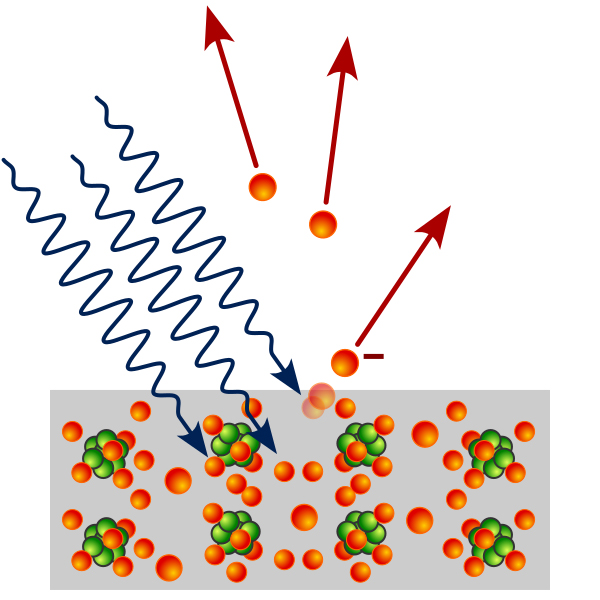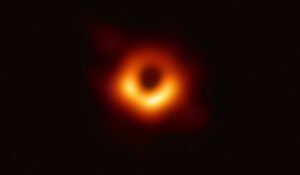
Figure 1: The photoelectric effect as explained by Albert Einstein. Photons (the blue squiggly lines) are aimed at and absorbed by electrons (red balls), causing the electrons to excite and be emitted from its position. A team of researchers have exploited this phenomenon to make negatively charged electrons attract each other.
Source: Wikimedia Commons
Opposite charges attract and like charges repel. This is the rule that every student learns in high school chemistry class, and it is the basis for the formation of atoms, molecules, and everything we refer to as matter. This rule is a consequence of the electromagnetic force, one of the four fundamental forces of the universe, and it has been irrefutable for close to a century. However, this classical notion has now been defied. A team of researchers led by professor Simone de Liberato from the School of Physics and Astronomy at the University of Southampton in the UK demonstrated for the first time that negative charges can be “glued” together using photons–the particles that compose light. The result is a novel form of matter named a Photon Bound Exciton.1
The team at Southampton created a nano device that contained trapped electrons embedded in its nanoscopic walls. First, they established that photons striking the walls of the device with a high enough energy excited the electrons, causing them to be emitted. This was an expected result of the photoelectric effect, the phenomenon explained by Einstein in 1905 that established that light could also exhibit particle-like behavior (Figure 1).1,2 Then, the researchers enclosed the device between two gold mirrors, trapping the photons inside. They did this in order to focus the luminous energy of the photons close to the electrons, which increased the number of interactions between the particles. The researchers observed that the electrons remained trapped in between the mirrors, bound to the other negatively charged electrons. Furthermore, they found that the electrons were held together in a novel electronic configuration that was stabilized by the presence of the photons.1
In simple terms, the team demonstrated how to use light as a sort of subatomic “zip tie.” This new insight into light-matter coupling demonstrates the possibility of engineering artificial atoms and other atom-like objects, which can expand the list of materials available for scientific and technological applications.1Additionally, this study has direct applications to optoelectronics (the branch of technology concerned with the combined use of light and electronics) and semiconductor heterostructures (a transition layer between two dissimilar semiconductors), increasing the broad range of use in the field of photonics.3 With further study, it is only a matter of time until engineers in the field of photonics create novel devices that can exploit this new use of light.
References
- University of Southampton. (2020, August 17). Scientists use photons as threads to weave novel forms of matter. ScienceDaily. Retrieved August 19, 2020 from www.sciencedaily.com/releases/2020/08/200817123036.htm
- Encyclopaedia Britannica. (2020, July 17). Photoelectric effect. Encyclopaedia Britannica. Retrieved August 19, 2020 from https://www.britannica.com/science/photoelectric-effect/Applications
- Cortese, E., Tran, N.L., Manceau, J.M., Bousseksou, A., Carusotto, L., Biasiol, G., Colombelli, R., & De Liberato, S. (2020, August 17). Excitons bound by photon exchange. Nature. Retrieved August 19, 2020 from https://www.nature.com/articles/s41567-020-0994-6
Related Posts
Primordial Black Holes: The Key to Dark Matter?
Figure 1: The first picture of a blackhole Source: Wikimedia...
Read MoreNew-clear Reactors: Newly approved nuclear reactor designs seek to improve on old ones
Figure 1: Shown by the red line, the sharp increase...
Read MoreCarbon-foam Light Sailing Could Take Us to the Stars in No Time
Figure 1: This is an image of LightSail 2, launched...
Read MoreSai Rayasam



